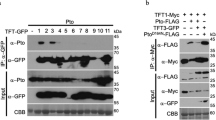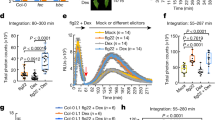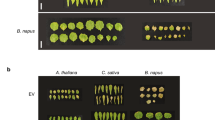Abstract
Plant nucleotide-binding leucine-rich repeat receptors (NLRs) are intracellular immune receptors that are activated by their direct or indirect interactions with virulence effectors. NLR activation triggers a strong immune response and consequent disease resistance. However, the NLR-driven immune response can be targeted by virulence effectors. It is thus unclear how immune activation can occur concomitantly with virulence effector suppression of immunity. Recent observations suggest that the activation of effector-triggered immunity does not sustain defence gene expression in tissues in contact with the hemi-biotrophic pathogen Pseudomonas syringae pv. tomato. Instead, strong defence was observed on the border of the infection area. This response is reminiscent of localized acquired resistance (LAR). LAR is a strong defence response occurring in a ~2 mm area around cells in contact with the pathogen and probably serves to prevent the spread of pathogens. Here we propose that effector-triggered immunity is essentially a quarantining mechanism to prevent systemic pathogen spread and disease, and that the induction of LAR is a key component of this mechanism.
This is a preview of subscription content, access via your institution
Access options
Access Nature and 54 other Nature Portfolio journals
Get Nature+, our best-value online-access subscription
$29.99 / 30 days
cancel any time
Subscribe to this journal
Receive 12 digital issues and online access to articles
$119.00 per year
only $9.92 per issue
Buy this article
- Purchase on Springer Link
- Instant access to full article PDF
Prices may be subject to local taxes which are calculated during checkout



Similar content being viewed by others
References
Jones, J. D. G., Vance, R. E. & Dangl, J. L. Intracellular innate immune surveillance devices in plants and animals. Science 354, aaf6395 (2016).
Jones, J. D. G. & Dangl, J. L. The plant immune system. Nature 444, 323–329 (2006).
Laflamme, B. et al. The pan-genome effector-triggered immunity landscape of a host–pathogen interaction. Science 367, 763–768 (2020).
Van de Weyer, A. L. et al. A species-wide inventory of NLR genes and alleles in Arabidopsis thaliana. Cell 178, 1260–1272.e14 (2019).
Huang, S. et al. Identification and receptor mechanism of TIR-catalyzed small molecules in plant immunity. Science 377, eabq3297 (2022).
Wan, L. et al. TIR domains of plant immune receptors are NAD+-cleaving enzymes that promote cell death. Science 365, 799–803 (2019).
Yu, D. et al. TIR domains of plant immune receptors are 2′,3′-cAMP/cGMP synthetases mediating cell death. Cell 185, 2370–2386.e18 (2022).
Essuman, K., Milbrandt, J., Dangl, J. L. & Nishimura, M. T. Shared TIR enzymatic functions regulate cell death and immunity across the tree of life. Science 377, eabo0001 (2022).
Jia, A. et al. TIR-catalyzed ADP-ribosylation reactions produce signaling molecules for plant immunity. Science 377, eabq8180 (2022).
Jacob, P. et al. Plant ‘helper’ immune receptors are Ca2+-permeable nonselective cation channels. Science 373, 420–425 (2021).
Bi, G. et al. The ZAR1 resistosome is a calcium-permeable channel triggering plant immune signaling. Cell 184, 3528–3541.e12 (2021).
Förderer, A. et al. A wheat resistosome defines common principles of immune receptor channels. Nature 610, 532–539 (2022).
Köster, P., DeFalco, T. A. & Zipfel, C. Ca2+ signals in plant immunity. EMBO J. 41, e110741 (2022).
Jacob, P. et al. Broader functions of TIR domains in Arabidopsis immunity. Proc. Natl Acad. Sci. USA 120, e2220921120 (2023).
Tian, H. et al. Activation of TIR signalling boosts pattern-triggered immunity. Nature 598, 500–503 (2021).
Ngou, B. P. M., Ahn, H. K., Ding, P. & Jones, J. D. G. Mutual potentiation of plant immunity by cell-surface and intracellular receptors. Nature 592, 110–115 (2021).
Yuan, M. et al. Pattern-recognition receptors are required for NLR-mediated plant immunity. Nature 592, 105–109 (2021).
Pruitt, R. N. et al. The EDS1–PAD4–ADR1 node mediates Arabidopsis pattern-triggered immunity. Nature https://doi.org/10.1038/s41586-021-03829-0 (2021).
Tena, G. PTI and ETI are one. Nat. Plants 7, 1527 (2021).
Wei, H. L., Zhang, W. & Collmer, A. Modular study of the type III effector repertoire in Pseudomonas syringae pv. tomato DC3000 reveals a matrix of effector interplay in pathogenesis. Cell Rep. 23, 1630–1638 (2018).
Guo, M., Tian, F., Wamboldt, Y. & Alfano, J. R. The majority of the type III effector inventory of Pseudomonas syringae pv. tomato DC3000 can suppress plant immunity. Mol. Plant. Microbe Interact. 22, 1069–1080 (2009).
Ruiz-Bedoya, T., Wang, P. W., Desveaux, D. & Guttman, D. S. Cooperative virulence via the collective action of secreted pathogen effectors. Nat. Microbiol. 8, 640–650 (2023).
Ross, A. F. Localized acquired resistance to plant virus infection in hypersensitive hosts. Virology 14, 329–339 (1961).
Bomblies, K. et al. Autoimmune response as a mechanism for a Dobzhansky–Muller-type incompatibility syndrome in plants. PLoS Biol. 5, e236 (2007).
Calvo-Baltanás, V., Wang, J. & Chae, E. Hybrid incompatibility of the plant immune system: an opposite force to heterosis equilibrating hybrid performances. Front. Plant Sci. 11, 2308 (2021).
Saile, S. C. et al. Two unequally redundant ‘helper’ immune receptor families mediate Arabidopsis thaliana intracellular ‘sensor’ immune receptor functions. PLoS Biol. 18, e3000783 (2020).
Cui, H. et al. A core function of EDS1 with PAD4 is to protect the salicylic acid defense sector in Arabidopsis immunity. N. Phytol. 213, 1802–1817 (2017).
Kim, N. H., Jacob, P. & Dangl, J. L. Con-Ca2+-tenating plant immune responses via calcium-permeable cation channels. N. Phytol. 234, 813–818 (2022).
Mcdowell, J. M. et al. Downy mildew (Peronospora parasitica) resistance genes in Arabidopsis vary in functional requirements for NDR1, EDS1, NPR1 and salicylic acid accumulation. Plant J. 22, 523–529 (2000).
Lapin, D. et al. A coevolved EDS1–SAG101–NRG1 module mediates cell death signaling by TIR-domain immune receptors. Plant Cell 31, 2430 (2019).
Castel, B. et al. Diverse NLR immune receptors activate defence via the RPW8–NLR NRG1. N. Phytol. 222, 966–980 (2019).
Wu, Z. et al. Differential regulation of TNL-mediated immune signaling by redundant helper CNLs. N. Phytol. 222, 938–953 (2019).
Rufián, J. S. et al. Confocal microscopy reveals in planta dynamic interactions between pathogenic, avirulent and non‐pathogenic Pseudomonas syringae strains. Mol. Plant Pathol. 19, 537–551 (2018).
Alvarez, M. E. et al. Reactive oxygen intermediates mediate a systemic signal network in the establishment of plant immunity. Cell 92, 773–784 (1998).
Costet, L. et al. Relationship between localized acquired resistance (LAR) and the hypersensitive response (HR): HR is necessary for LAR to occur and salicylic acid is not sufficient to trigger LAR. Mol. Plant Microbe Interact. 12, 655–662 (1999).
Dorey, S. et al. Spatial and temporal induction of cell death, defense genes, and accumulation of salicylic acid in tobacco leaves reacting hypersensitively to a fungal glycoprotein elicitor. Mol. Plant Microbe Interact. 10, 646–655 (1997).
Ross, A. F. Systemic acquired resistance induced by localized virus infections in plants. Virology 14, 340–358 (1961).
Betsuyaku, S. et al. Salicylic acid and jasmonic acid pathways are activated in spatially different domains around the infection site during effector-triggered immunity in Arabidopsis thaliana. Plant Cell Physiol. 59, 8–16 (2018).
Ghareeb, H. et al. Quantitative hormone signaling output analyses of Arabidopsis thaliana interactions with virulent and avirulent Hyaloperonospora arabidopsidis isolates at single-cell resolution. Front. Plant Sci. 11, 1737 (2020).
Samac’, D. A. & Shah, D. M. Developmental and pathogen-induced activation of the Arabidopsis acidic chitinase promoter. Plant Cell 3, 1063–1072 (1991).
Roberts, M., Tang, S., Stallmann, A., Dangl, J. L. & Bonardi, V. Genetic requirements for signaling from an autoactive plant NB-LRR intracellular innate immune receptor. PLoS Genet. 9, e1003465 (2013).
Bonardi, V. et al. Expanded functions for a family of plant intracellular immune receptors beyond specific recognition of pathogen effectors. Proc. Natl Acad. Sci. USA 108, 16463–16468 (2011).
Jabs, T., Dietrich, R. A. & Dangl, J. L. Initiation of runaway cell death in an Arabidopsis mutant by extracellular superoxide. Science 273, 1853–1856 (1996).
Hander, T. et al. Damage on plants activates Ca2+-dependent metacaspases for release of immunomodulatory peptides. Science 363, eaar7486 (2019).
Zhu, J. et al. Single-cell profiling of Arabidopsis leaves to Pseudomonas syringae infection. Cell Rep. 42, 112676 (2023).
Salguero-Linares, J. et al. Robust transcriptional indicators of immune cell death revealed by spatiotemporal transcriptome analyses. Mol. Plant 15, 1059–1075 (2022).
Delannoy, E. et al. Cell specialization and coordination in Arabidopsis leaves upon pathogenic attack revealed by scRNA-seq. Preprint at bioRxiv https://doi.org/10.1101/2023.03.02.530814 (2023).
Liu, X. et al. Dynamic decomposition of transcriptome responses during plant effector-triggered immunity revealed conserved responses in two distinct cell populations. Preprint at bioRxiv https://doi.org/10.1101/2022.12.30.522333 (2022).
Nobori, T. et al. Time-resolved single-cell and spatial gene regulatory atlas of plants under pathogen attack. Preprint at bioRxiv https://doi.org/10.1101/2023.04.10.536170 (2023).
Misas-Villamil, J. C., Kolodziejek, I. & Van Der Hoorn, R. A. L. Pseudomonas syringae colonizes distant tissues in Nicotiana benthamiana through xylem vessels. Plant J. 67, 774–782 (2011).
Liu, Y., Schiff, M., Marathe, R. & Dinesh-Kumar, S. P. Tobacco Rar1, EDS1 and NPR1/NIM1 like genes are required for N-mediated resistance to tobacco mosaic virus. Plant J. 30, 415–429 (2002).
Lepiniec, L. et al. Genetics and biochemistry of seed flavonoids. Annu. Rev. Plant Biol. 57, 405–430 (2006).
Wright, K. M. et al. Analysis of the N gene hypersensitive response induced by a fluorescently tagged tobacco mosaic virus. Plant Physiol. 123, 1375 (2000).
Baebler, Š. et al. Salicylic acid is an indispensable component of the Ny-1 resistance-gene-mediated response against potato virus Y infection in potato. J. Exp. Bot. 65, 1095–1109 (2014).
Chandra-Shekara, A. C. et al. Signaling requirements and role of salicylic acid in HRT- and rrt-mediated resistance to turnip crinkle virus in Arabidopsis. Plant J. 40, 647–659 (2004).
Sánchez, G. et al. Salicylic acid is involved in the Nb-mediated defense responses to potato virus X in Solanum tuberosum. Mol. Plant. Microbe Interact. 23, 394–405 (2010).
Torres, M. A., Jones, J. D. G. & Dangl, J. L. Pathogen-induced, NADPH oxidase-derived reactive oxygen intermediates suppress spread of cell death in Arabidopsis thaliana. Nat. Genet. 37, 1130–1134 (2005).
Torres, M. A., Dangl, J. L. & Jones, J. D. G. Arabidopsis gp91phox homologues AtrbohD and AtrbohF are required for accumulation of reactive oxygen intermediates in the plant defense response. Proc. Natl Acad. Sci. USA 99, 517–522 (2002).
Torres, M. A., Jones, J. D. G. & Dangl, J. L. Reactive oxygen species signaling in response to pathogens. Plant Physiol. 141, 373–378 (2006).
Miller, G. et al. The plant NADPH oxidase RBOHD mediates rapid systemic signaling in response to diverse stimuli. Sci. Signal. 2, ra45 (2009).
Bendahmane, A., Kanyuka, K. & Baulcombe, D. C. The Rx gene from potato controls separate virus resistance and cell death responses. Plant Cell 11, 781–791 (1999).
Gross, P., Julius, C., Schmelzer, E. & Hahlbrock, K. Translocation of cytoplasm and nucleus to fungal penetration sites is associated with depolymerization of microtubules and defence gene activation in infected, cultured parsley cells. EMBO J. 12, 1735–1744 (1993).
Li, L. & Weigel, D. One hundred years of hybrid necrosis: hybrid autoimmunity as a window into the mechanisms and evolution of plant–pathogen interactions. Annu. Rev. Phytopathol. 59, 213–237 (2021).
Barragan, A. C. et al. A truncated singleton NLR causes hybrid necrosis in Arabidopsis thaliana. Mol. Biol. Evol. 38, 557–574 (2021).
Cheng, Y. T. et al. Stability of plant immune-receptor resistance proteins is controlled by SKP1-CULLIN1-F-box (SCF)-mediated protein degradation. Proc. Natl Acad. Sci. USA 108, 14694–14699 (2011).
Zavaliev, R., Mohan, R., Chen, T. & Dong, X. Formation of NPR1 condensates promotes cell survival during the plant immune response. Cell 182, 1093–1108.e18 (2020).
Acknowledgements
We thank T. Nobori, J. G. Ellis, G. L. Coaker and T. Nuernberger for constructive critical reading of the manuscript and members of the Dangl lab for useful discussions. This research was supported by the National Science Foundation (grant no. IOS-1758400 to J.L.D.) and the Howard Hughes Medical Institute (HHMI). J.L.D. is an HHMI Investigator. This article is subject to HHMI’s Open Access to Publications policy. HHMI lab heads have previously granted a non-exclusive CC BY 4.0 licence to the public and a sublicensable licence to HHMI in their research articles. Pursuant to those licences, the author-accepted manuscript of this article can be made freely available under a CC BY4.0 licence immediately upon publication.
Author information
Authors and Affiliations
Contributions
P.J. conceptualized the project, wrote the original draft, reviewed and edited the manuscript, and conducted the formal analysis. J.H. conducted the investigation. J.L.D. conceptualized the project, reviewed and edited the manuscript, acquired the funding and supervised the project.
Corresponding author
Ethics declarations
Competing interests
The authors declare no competing interests.
Peer review
Peer review information
Nature Plants thanks Matthieu Joosten and the other, anonymous, reviewer(s) for their contribution to the peer review of this work.
Additional information
Publisher’s note Springer Nature remains neutral with regard to jurisdictional claims in published maps and institutional affiliations.
Rights and permissions
Springer Nature or its licensor (e.g. a society or other partner) holds exclusive rights to this article under a publishing agreement with the author(s) or other rightsholder(s); author self-archiving of the accepted manuscript version of this article is solely governed by the terms of such publishing agreement and applicable law.
About this article
Cite this article
Jacob, P., Hige, J. & Dangl, J.L. Is localized acquired resistance the mechanism for effector-triggered disease resistance in plants?. Nat. Plants 9, 1184–1190 (2023). https://doi.org/10.1038/s41477-023-01466-1
Received:
Accepted:
Published:
Issue Date:
DOI: https://doi.org/10.1038/s41477-023-01466-1
This article is cited by
-
How plants manage pathogen infection
EMBO Reports (2023)



